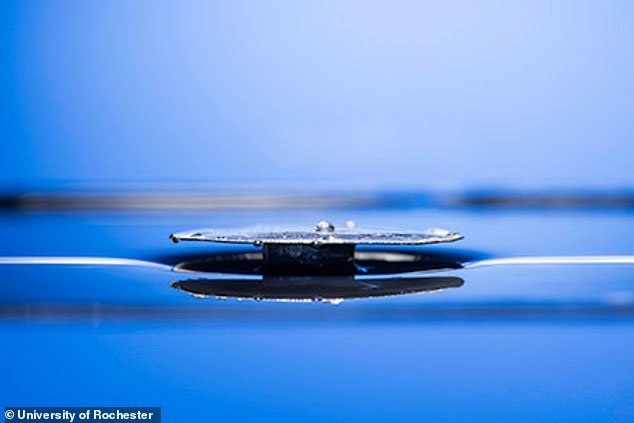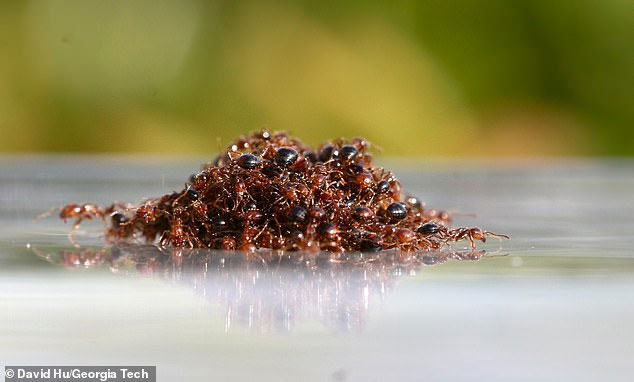The new metal cannot be submerged in water, inspired by fire ants
Fire ants and diving bell spiders have inspired scientists to create a water-resistant metal that can be used to build unsinkable ships.
The Daily Mail reported that to create the special metal, the team at the University of Rochester (USA) used a very short laser beam to 'engrave' tiny lines on the surface of aluminum foil. it to keep the air.

Metal pieces float on the surface of the water after being treated with high technology.(Photo: Daily Mail).
Even when they submerge the metal into the water, it will rise again and continue to float on the surface as soon as the pressure is released.
'This material could be used to build a submerged vessel or a floating device, which is still floating on the water despite a puncture, or an electronic surveillance device capable of long-term operation on the ocean. Yang, '' Professor Chunlei Guo, who led the study, wrote in the scientific journal ACS Applied Materials and Interfaces.
Fire ants can survive for long periods below or above water by gathering their legs to form a raft. They then block the air with their own water-resistant bodies, helping them float on the surface of the water.

Fire ants can survive for long periods below or above water.(Photo: Daily Mail).
The team also drew on the idea of making a diving bell spider (Argyroneta aquatic) . This creature creates a balloon in their abdomen and legs, or 'diving bell'. It then uses air in the balloon to breathe and only floats to the surface of the water when it needs to reload.
Professor Guo used this method to store air in bubbles to ensure that after a long period of underwater, his metal structures could still contain enough air to float when returning to the water. .
This process involves placing two treated aluminum pieces face-to-face, with just enough space between them to create an air bubble. The two surfaces will become super water resistant and prevent water from overflowing into the center compartment even if the structure is submerged underwater.
Not only effective for aluminum, Dr. Guo said the 'etching process' - the focus of creating a water-resistant object surface - is applicable to other metals and materials.
The team tested the new metal by applying pressure to keep it underwater for longer periods of time, then observed whether it continued to float. As a result, after being submerged for two months, the structure immediately rose to the surface when the pressure was released. They also tried to penetrate many holes in the metal surface and found it was still floating because the air bubble was still intact.
The first time he used 'engraving' technology, Mr. Guo's team took an hour to carve a small space on the surface. Now, with the use of stronger lasers and faster scanners, Mr. Guo was able to speed up the process, making it more feasible to put it into practice.
If the metal is produced on a large scale, it has the potential to be used to build unsinkable ships, boats, or wearable assistive devices, even after a puncture.
- Teamwork helps fire ants to die in floods
- Video: 'Storm' fire ant makes all species of canvas
- Rare photos: Fire ants stand with one leg
- Fire ants' super prize math like people
- Detecting a 'killer' ants can be deadly in Korea
- Interesting myth about fire metal
- Amazingly huge ants fire floating in the super typhoon in America
- Research fire ant behavior to develop rescue robots, waterproofing materials
- England: Discovering ants is likely to cause house fires
- The fire ants formed a solid tower to overcome obstacles
- Discover strange ants in the world
- The ants build rafts on the water
 The US company is about to build a supersonic passenger plane of 6,000km / h
The US company is about to build a supersonic passenger plane of 6,000km / h Japan develops avatar robot as in fiction film
Japan develops avatar robot as in fiction film Australia tested the world's first mango picking robot
Australia tested the world's first mango picking robot Finland installs the world's first sand cell system
Finland installs the world's first sand cell system